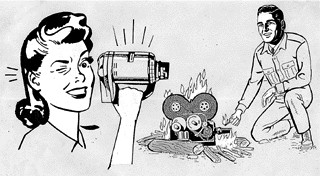DVolution
Local filmmaking classes for the digital auteur
By Marc Savlov, Fri., Nov. 23, 2001

If you're one of the many people who've gotten their hands on a digital video camera in the past year or so, then chances are you know how endearingly simple they are to use. Push one button and crisp, clean digital images are captured, press another and a host of in-camera effects are rendered, and press yet another and ... well, it's no longer a question of what can you do, but what can't you. This is all well and good for the aspiring filmmaker (and these days who isn't?), but the skills needed to shoot, craft, and edit a rough assemblage of shaky-cam shots into something resembling a serious attempt at filmmaking are still as arcane and indispensable as they've ever been.
The University of Texas' flagship Radio/ Television/Film program is still the most comprehensive way to learn the basics and beyond, not only for film but also for video, but few people other than dedicated students have the time or impetus to undertake that sort of rigorous, life-changing program. For the rest of us -- weekend film- and videomakers who just want to figure out what a white balance is or how to shoot day-for-night without using one of those crappy step-up filters -- the options are limited.
This wasn't always the case. Until recently, Austin played host to the well-received Austin DV Center, which acted as a local clearing house for information and classes in the rapidly evolving medium. The DV Center has since closed up shop, however, due to other commitments on the part of those who ran it, leaving only a handful of other outlets available to interested wannabe-filmmakers.
One of these is Stephen Mims' long-running Production I and II courses, available as part of Austin Filmworks (www.austinfilmworks.org), which offer college-level film courses that provide a working knowledge of everything from pre-production to editing. Mims' six-week courses are an Austin industry standard, and pretty much everyone agrees they're the best thing going for people who want to learn not only the basics of film but, more recently, DV as well.
Mims, who taught the courses for UT's RTF department for four years prior to taking them public, knows this stuff inside and out. His feature film The Perfect Specimen has played SXSW and a host of other national festivals, and his short film "Aunt Hallie" was called one of the funniest 10-minute films of all time by no less than Vincent Canby.
Asked how the DV revolution has impacted his classes, Mims says, "It's been about three years now that we've been editing all of the final projects on the computer, nonlinearly. We have three options to do that with: Final Cut Pro, Adobe Premiere, and iMovie 2. It just depends on the amount of experience coming in here. Some people don't have any Macintosh experience at all, and all three of those programs are Mac-based. The best thing is that the iMovie software is intuitive enough that even people who may not have much Mac experience can get up to speed on it in a very short time usually."
Mims' Production I course is a comprehensive introduction to film and video pre-production, production, and post-production -- a true hybrid class that teaches the basics of both film and DV.
"It's virtually the same, in many respects, as the Film I class that I taught at UT for four years," says Mims. "The only difference is that in addition to the film content that I had been teaching previously I've now added all the digital and electronic or video components as well.
"We try to cover all the big production issues from scratch. The students shoot two-camera exercises -- in one of them I give them a storyboard and they do in-camera edits and so on, and then there's a second exercise that they design, from scratch, and then finally there's a final project, a five-minute piece of the student's design, done on videotape, any kind of format. If it's not digital when they shoot it, we convert it and then it all goes into a Mac for editing."
Production II is a 14-week course that picks up where the first class left off. Limited to 15 students, as is Production I, the class requires that members produce three final projects, shot on 16mm and then transferred to videotape for editing. Stressing professional cinematography skills, it's as hands-on as you can get with going to film school.
"These two classes aren't focused exclusively on either post-production," adds Mims, "like it would be if it were just a [digital-editing software] Final Cut Pro class, or production, for that matter. We try to give people all the basic information that they need so that when they leave those classes they can make their own films and understand what the bigger issues really are. In other words, the big mistakes that they shouldn't make and the preparation that they really need in order to make a film."
Speaking of Apple's insanely great Final Cut Pro editing software, the other class that budding DV auteurs have open to them -- excluding courses from both UT and Austin Access, which are the stuff of another article in and of themselves -- is local filmmaker J. Kevin Smith's course Final Cut Pro class, also available from Austin Filmworks. Give the man two days of your life (Saturday and Sunday, natch) and he'll give you skills to, if not pay the bills, then at least to edit a decent piece of film or video nonlinearly.
Smith, who recently acted as the Final Cut Pro consultant to editor Sandra Adair on Richard Linklater's new film Waking Life, is obviously psyched about the software's abilities.
"We cover everything about FCP you could want to know," he says. "We do as much in two days as we can, which is a lot, from the basics of importing your video from your camera to your computer system, to adding effects and filters and whatnot, to getting it back out onto videotape to watch.
"We limit the class to six people. Everybody gets their own computer system to work from, so it's not just a lecture class, and everybody gets to follow along and do what I'm showing them on their own computer. It's for beginners, people who have never really edited before or people who aren't really familiar with Final Cut Pro. Basic computer skills are a necessity, but you don't need to know anything about editing when you come in."
Between Mims and Smith's classes, Austin's auteurs-in-the-making have a wealth of material available to them. If you've got the camera -- hey, Santa! -- there's no longer any reason not to make the film. And if something as technically simplistic (and inspired, sure) as The Blair Witch Project can virtually redefine American cinema overnight, then why can't you? ![]()








